Working toward legislation to curb light pollution in Illinois.
It makes sense to start off this discussion by addressing the topic of digital billboards and the future. The large outdoor advertising companies have embraced this technology as the replacement for static signage; in their book, it is the technology which is here to stay. To quote a promotional video from the Trans-Lux company, "Nothing’s as eye-catching as an electronic LED display. The brightly-lit text and graphics can be seen from hundreds of feet away, drawing the attention of everyone within view.” Space on the electronic signs is marketed as being superior to that on static signs; it can cost as much or more to run your company's sign on the digital billboard as to rent a static one, even though your sign may only be shown a small percentage of the time on the digital display, alternating with as many as eight or more others. While the investment in a digital sign is a large one (often quoted as $250,000 - $500,000), the anticipated return is great. Overhead costs are also cut for the advertising companies; when signs are designed, they no longer need to be printed, and then installed by a crew in the field; at the click of a computer mouse, the sign graphic is wired or radioed to the digital billboard for display. The companies in the multi-billion-dollar outdoor advertising field have a large financial incentive to change most outdoor signage from static to digital over the coming years. Why is our coalition for responsible outdoor lighting discussing the subject of digital billboards? There are a few issues which directly involve questions of illumination which we address. The signs emit light into the nocturnal environment, potentially including residential and natural areas and the sky; they consume large amounts of electricity; their presence can affect public safety, most commonly by distracting drivers (which, after all, is the signs' precise intent and purpose). To understand these issues, and consider ordinances which should regulate the placement and operation of these signs, we need to understand the details of how the various effects are measured. Unfortunately, this is not common knowledge; state and local managers may not be familiar with principles and metrics which apply. Our intent in this paper is to provide some practical definitions, and cite sensible, logical and defensible levels of regulation.
Illuminance (illumination) is usually measured in units of foot-candles or lux; luminance (surface brightness) is most often measured in nits or candela per square meter (cd/m2), which are equivalent. (For further discussion of these units or any other technical terms used in this paper, see our website's Encyclopedia of Terms page.) Luminance plays a critical role in how a sign like a billboard interacts with the environment around it. During the daytime, a static billboard lit by the natural daylight will appear to the eye to have a brightness which "fits in" with its surroundings; it will not cause excessive distraction because of an unusual level of luminance. (Perception studies show that having something in our field of vision which is either much brighter or darker than its surroundings causes an involuntarily shift of our vision to the object.) A digital sign which is set to a luminance level higher than that of the other objects around it, which are lit by daylight alone, can potentially draw a driver's eyes to the sign when they need to be looking elsewhere to safely operate their vehicle; levels can even be so high as to cause vision-disturbing glare. The luminance level which a digital sign needs to be set at to be visible in the daylight is far above that needed at dusk or night. This effect can be seen with other luminous displays, such as on cellphones and laptop computers; brightness levels which seem high indoors are totally inadequate outside in the much brighter direct sunlight. The eye of the driver at night compensates for lower light levels by becoming more sensitive to light; it is even more easily distracted, dazzled, and even disabled by an overly luminous object than the daytime eye is. SAFE AND SENSIBLE LIMITS FOR LUMINANCE For daylight hours, the maximum luminance level for digital signage should be similar to what the luminance of an identical sign would be if it was printed out and installed on a static billboard. In other words, the digital sign would appear no brighter, no more intense, that the printed sign next to it, or the landscape surrounding it. In practice, setting a limit of 5000 nits (setting the sign's intensity so that an area on it displaying full-brightness white has no higher luminance than that figure) ends up delivering a surface brightness similar to landscape illuminated by sunlight. 
At dusk and nighttime, a logical conclusion would be that new digital billboards do not need to operate at higher surface brightness than the static ones which they are replacing. The outdoor advertising industry has not, for decades, been telling its customers that their nighttime advertising is ineffective; quite the contrary. So, what could be the rationale for setting nighttime luminance limits which are higher than the brightness of the existing static signs? However, if such limits are not set, it seems that the advertising industry will be pushing the envelope out further and further, increasing the distractive effects of the digital signs, the potential disruption of visual perception, and the flooding of the surrounding neighborhoods with excess light. The single photograph in the frame above, taken May 24, 2010, shows two adjacent billboards; the one in back (left) a static sign, lit from below by metal halide luminaires, which obviously has a lower surface brightness that the one in front (right), which is digital. From independent surveys of static billboards, we have a good summary of levels of surface brightness that those signs are currently commonly operated at. A 2009 survey of static billboards in Arizona found that, out of 565 measured, 98% had a luminance of less than 150 nits, and 83% measured below 100 nits. A smaller 2008 survey1 in New York State found an average nighttime luminance of 124 nits for static billboards. The IESNA Lighting Handbook2 recommends for “illuminated billboards and other large advertising panels”, illuminating such signs at night with 1000 lux in bright locations, and 500 lux for ones in dark surroundings. Assuming that a static billboard has a white face with a reflectance of 0.8, the luminance of such a billboard would be 250 nits in the setting (1000 lux) for brightly illuminated surroundings, and 125 nits in the low-light setting (500 lux illumination). Many digital billboards are mounted on tall masts, above the driver/viewer, so they appear to "hang in the sky"; at night, this would place them against that dark background, making the darker-surroundings setting appropriate. MEASURING LUMINANCE
With the luminance meter, the brightness measurement can be taken in any condition of ambient light -- bright or cloudy day, dusk, or night. With the illuminance method, daytime light levels will overpower the light readings; separating out the contribution from the sign will be next to impossible to do to any level of accuracy. Finding this flaw in Lewin's proposal is not surprising, because he does not address the subject of limiting luminance during the daylight hours. When discussing digital billboard technology, this is a glaring omission (no pun intended). Current production models of LED displays can achieve surface brightness of over 13,000 nits4; this is intensly bright in the daylight, especially on overcast days. (As a comparison, the bright blue daytime sky ranges from around 5,000 to 7,000 nits in luminance.) We need to set limits for daytime sign luminance, too, and to be able to measure that performance. With the luminance meter, the apparent surface brightness can be measured at any angle; this includes taking measurements directly from whatever areas of roadway where the sign will be in view. If the Lewin measurement is taken from the ground in front of the sign, that will often place the observer notably below the sign (billboards along roadways often being mounted high off the ground, especially those installed along elevated highways). The light emanating from digital billboards is somewhat directional; it is notably more intense along an axis extending out perpendicularly from the sign's face, and drops off in intensity as the angle away from that axis increases. The observer at ground level, often 30 feet or more below the lower edge of sign, will not be intercepting the most intense output of light. The Lewin method requires manipulating the sign display, to take one reading with the sign on, and one with it off. This precludes the ability to independently measure sign luminance for code enforcement, because the sign operators will be choosing the luminance settings during the test. With a luminance meter, any sign can be checked for compliance at any time, without requiring the involvement of the sign owner/operator. LIGHT TRESPASS In his paper, Lewin uses the term "light trespass," but not in the way which it has normally been addressed in outdoor lighting regulation. He posits a set of distances away from the billboards at which to measure illuminance levels, rather than using the fairly standardized concept of property boundaries. His measurement points (at as far as 350' from the sign) might end up being on the same parcel which the sign in question is located on, or the next one over, or one beyond that. This points out a major difference between sign illumination and most other outdoor illumination; the later generally serves the purpose of illuminating the property it is installed on; the former (signs) are often intended expressly to illuminate (be seen from) adjoining properties, or across entire neighborhoods. So, comparing the Lewin proposal for limiting "trespass" to the traditional concept of limiting light trespass is difficult. He arrives (through, I might add, what seems to be an elaborate use of cherry-picked logic) at a figure of 0.3 foot-candles as his recommended limit for nighttime trespass at his table of random distances out in front of various billboard sizes. This shouldn't be mistakenly equated with the location of a neighboring property; if there was 0.3 f.c. at 350', but a house was only 175' away, the trespass level to that house would be four times higher. Trespass should be measured to property lines. Admittedly, this puts billboards at a disadvantage; it is not uncommon for them to be located on parcels which are barely larger than the footprint of the signs themselves. But why should they be allowed to light up adjacent properties any more than any other form of artificial illumination? Some municipalities, townships, counties and states have light trespass regulations. For trespass on to properties with any residential class of zoning, a limit of 0.1 foot-candles is not uncommon. In Illinois, some jurisdictions which have the 0.1 f.c. limit include Barrington Hills, Crystal Lake, Elk Grove, Homer Glen, Mt. Prospect, Mt. Vernon, Naperville, Palatine, Park Ridge, Springfield, Urbana, and even Scott Air Force Base. MOTION & DISTRACTION First, they limit their suggestion to not use moving images to full-sized billboards only. It is fine with them if "street-sized" signs along the roadways in our busy towns and cities feature any sort of animation or television-like video. Apparently, they believe that roadway accidents caused by distraction only occur on highways. Second, when one image changes to another on a sign within a person's field of view, the viewer's visual system perceives that change as motion, even though the two images themselves were "static." (This is how motion pictures operate; they present the viewer a series of static images, and the mind "sees" motion.) If there is one sign ahead of us, and it turns into another, what we perceive is a flash, and/or movement. So, paradoxically, the billboard companies say they won't operate flashing or moving billboards, but they cannot avoid those effects if they change the displayed images while we are watching. They also display ads which continue on multiple "frames," encouraging the viewer to stare at the sign for a prolonged time to see the next installment. OTHER REAL-WORLD CONCERNS However, the light projection at lower angles above the horizontal is not impeded by the louvers. As described in the seminal paper "Lighting and Astronomy" by Luginbuhl, Walker & Wainscoat5, light emitted between the horizontal and just 20° above it contributes much more to skyglow than light emitted at higher angles, and that low-angle light's effects are visible over a much broader area. So, the sunshade louvers built into many digital signs do little to minimize their impact on the night sky. The outdoor advertisers like to point out some studies (most of which they commissioned) which show negligible traffic safety problems related to existing digital signage. But this is new technology; we don't have enough real-world data to make accurate judgments yet. There are vast numbers of billboards in the U.S. (the OAAA estimates 450,000), and only a tiny fraction have been converted to digital. Short-term analysis of that small percentage will not address the safety effect that large-scale, long term installation will have. Picture an Illinois highway which already has a bewildering display of billboards, like stretches of I-294 and I-55 near Chicago, with all of those signs converted to digital, changing displays. Now picture it with all those displays turned up to excessive brightness. Many of us can discern that such a situation would pose increased driving hazards, without the need for a study, or for the accidents, injuries and fatalities which might occur during the study period. The big "selling point" which the outdoor advertising companies use is that the digital signs may be used for posting Amber Alerts in real-time. This is a genuine public service, and is lauded by many in law enforcement. However, operating roadside signs every day and night at levels of brightness which makes them too highly distracting could negate the public safety positives of Amber Alerts by increasing everyone's risk of accident and injury in the vicinity. We have heard some people suggest that there are other distraction hazards on the roads which pose greater dangers, like drivers talking on cell phones, text messaging, eating, reading, etc. Yes, those are obvious real hazards. But their existence does not somehow make it logical that we should add even more distractions on the roadways of this country. Over thirty thousand people die each year here in traffic accidents; this is a horrible epidemic, and we need to be figuring out how to combat it, rather than shrugging off safety concerns. In the real world, once digital billboards are installed, most local regulatory agencies will find it virtually impossible to ever remove them. If they were allowed by existing regulations (or lack thereof) to be installed, even removal called for by a change in those regulations will generally require condemnation procedures to be instituted; that will entail the governmental body purchasing each offending sign from its owner. At a quarter to a half of a million dollars per sign, this cost is not affordable to most local governments, no matter how objectionable they or the citizens of the area have found the signs to end up being, how the land usage in the areas around the signs has changed over time, or if signs need to be removed because of road widening or other civic projects. SUMMARY
Considering the effect which large-scale outdoor signage may have on property values and quality of life issues, regulatory bodies should require public notification and allow public comment when sign permits are applied for, including requests to convert existing static billboards to digital.
1 "Evaluation of Billboard Sign Luminances", Lighting Research Center, Rensselaer Polytechnic Institute, March, 2008 2 "IESNA Lighting Handbook, Ninth Edition, July 2000, Mark Stanley Rea, ed. 3 "Digital Billboard Recommendations and Comparisons to Conventional Billboards", Ian Lewin Ph.D., FIES, L.C., Lighting Sciences, Inc., 2009 4 "P20 Outdoor Full Color LED Display", Shenzhen Only Optoelectronic Technology Co., Ltd. website, June, 2011 5 "Lighting and Astronomy", Luginbuhl, Walker & Wainscoat, Physics Today, December 2009 |
||||||||
Return to Page TopThis page available as an Adobe Acrobat document Here |
|||
light pollution Illinois Chicago Cook County DuPage County Will County Springfield energy enviromnent global warming anti light pollution legislation lighting ordinances |
|||


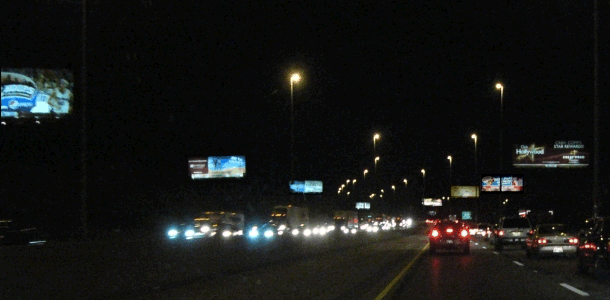
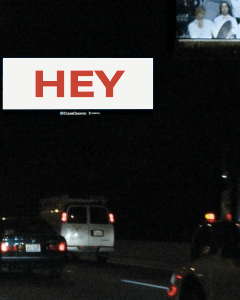
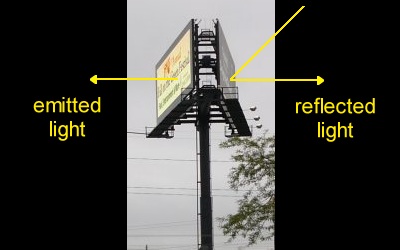
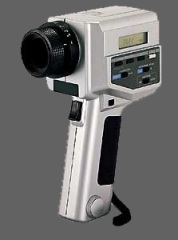 Luminance can be directly measured with a special instrument called a luminance meter. It works much like a camera, focusing on the surface which one is determining the brightness of, and measuring that surface's light output per angular degree of area. Lewin suggests that these meters, which may cost several thousand dollars, are too expensive for local sign installers and regulators to obtain. Therefore, instead of direct measurement with a luminance meter (like the one shown on the right), he suggests obtaining an approximate measurement by using a more common, generally less expensive illuminance light meter (as shown below). While the cost savings suggestion is laudable, the proposed indirect method contains several flaws when applied to real-world situations, leaving it, in our opinion, too lacking to use anywhere outside of the theoretical laboratory. Lewin's method involves positioning the observer with the light meter a known distance in front of the sign in question, and taking one measurement of all the light falling on the light meter while the sign is illuminated, and another reading while the sign is turned off. The difference between the two measurements should be the contribution of illuminance from the sign, and if you know the exact overall size of the sign, and just how far from the sign the measurements were taken, you can compute the approximate average surface brightness of the sign.
Luminance can be directly measured with a special instrument called a luminance meter. It works much like a camera, focusing on the surface which one is determining the brightness of, and measuring that surface's light output per angular degree of area. Lewin suggests that these meters, which may cost several thousand dollars, are too expensive for local sign installers and regulators to obtain. Therefore, instead of direct measurement with a luminance meter (like the one shown on the right), he suggests obtaining an approximate measurement by using a more common, generally less expensive illuminance light meter (as shown below). While the cost savings suggestion is laudable, the proposed indirect method contains several flaws when applied to real-world situations, leaving it, in our opinion, too lacking to use anywhere outside of the theoretical laboratory. Lewin's method involves positioning the observer with the light meter a known distance in front of the sign in question, and taking one measurement of all the light falling on the light meter while the sign is illuminated, and another reading while the sign is turned off. The difference between the two measurements should be the contribution of illuminance from the sign, and if you know the exact overall size of the sign, and just how far from the sign the measurements were taken, you can compute the approximate average surface brightness of the sign.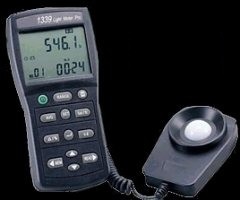 With a luminance meter, surface brightness can be measured from any (unspecified) distance, as long as the surface to be measured fills the field of view of the meter. With the indirect method, you need to know the distance precisely, and to use Lewin's "easy" table of calculation, the distance has to be a pre-set value, like 200 or 250 feet. In the real world, billboards are often located in hard to reach spots; 200' in front might be a private property, a highway, a pond, etc. To measure the distance in most situations, a tape measure would not be practical; either a laser rangefinder or a precise GPS unit would be needed; purchasing that equipment would notably reduce the cost difference between the luminance and illuminance meters.
With a luminance meter, surface brightness can be measured from any (unspecified) distance, as long as the surface to be measured fills the field of view of the meter. With the indirect method, you need to know the distance precisely, and to use Lewin's "easy" table of calculation, the distance has to be a pre-set value, like 200 or 250 feet. In the real world, billboards are often located in hard to reach spots; 200' in front might be a private property, a highway, a pond, etc. To measure the distance in most situations, a tape measure would not be practical; either a laser rangefinder or a precise GPS unit would be needed; purchasing that equipment would notably reduce the cost difference between the luminance and illuminance meters.